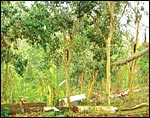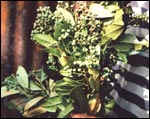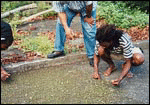Home | FOOD ARTICLES | Food Trivia | Today_in_Food_History | Food_History_Timeline | Recipes | Cooking_Tips | Food_Videos | Food_Quotes | Who’s_Who | Culinary_Schools_&_Tours | Food_Trivia_Quizzes | Food_Poems | Free_Magazines | Food_Festivals_and_Events
Food Articles, News & Features Section
FREE Magazines
and other Publications
Free Professional and Technical Research, White Papers, Case Studies, Magazines, and eBooks
ALLSPICE FIELD REPORT
See also: Allspice Trivia; Allspice Cooking Tips
Spice Buyer's Journal: Jamaica
I’m Al Goetze, chief spice buyer at McCormick. In this installment of the Spice Buyer’s Journal, we’re taking a look at one of the holiday season’s essential flavors – allspice. Discovered by Christopher Columbus during his voyage to the new world, allspice is known in Jamaica as pimento, a name derived from "pimienta," the Spanish word for pepper. Columbus had actually come to the islands seeking pepper, and mistakenly identified the abundant allspice berries as pepper.
Allspice is one of the most versatile — yet underutilized — spices in the world. Its flavor combines notes of cinnamon, clove and nutmeg. In fact, because it encompasses these three distinct tastes, many people believe that it is a blend instead of a single spice. Allspice is a key ingredient in such diverse recipes as desserts, pickled herring and of course, Caribbean Jerk seasoning.

Jamaica grows the best quality allspice, therefore, it is a key location to assess the current crop outlook. That fact is particularly significant this year, in the wake of Hurricane Ivan’s damaging visit to the island in early September.
On a recent early morning in Kingston, I met up with one of Jamaica’s major allspice collectors, who works directly with the local farmers. He brought me to the parish of Portland to see the crop firsthand. Allspice grows wild in all 14 parishes of Jamaica, with St. Ann, St. Elizabeth and Portland being the largest growers.

We traveled over two-lane roads, following the coastline. To our left, we could see the deep green color of the lush Blue Mountains. To our right were the clear aqua waters of the Caribbean Sea. Though a breathtakingly beautiful scene, the devastation from the hurricane is evident everywhere. Buildings and houses alongside the road were literally picked up and moved, or are just gone altogether. The road itself was undercut and washed away in many areas, and an entire concrete bridge was completely destroyed.
Because of this, what is normally a two-hour car ride became a bumpy four-hour trip. The storm, though not a direct hit, brought heavy rains, high ocean surge and strong winds — in excess of 100 mph — for a very long, sustained time.
Arriving in the village of Manchioneal, on the east coast of the island, we met two farmers, Jimbal and Junior, at their roadside fresh coconut stand. They escorted us to their nearby farms in the foothills of the Jamaican mountains.
Allspice is a beautiful, slender tree that can grow to 100 feet in height and live for more than 75 years. The wood of the tree is light tan in color and has a very thin, smooth outer bark. Its leaves are narrow and green, and are similar in shape to laurel (bay) leaves. The allspice berry is abundant and grows on the thin outer branches of the tree, about 15 feet above the ground. This fruit is slightly larger than the size of a black pepper berry and each is connected to the tree by a small stem.
Every year, the trees flower when the rains begin in May. Once pollinated, the trees produce mature berries from August through October. Jimbal told me that he looks to the birds to know when it is time to harvest the berries. The berries become a greenish purple color when ripe, and are sticky and sweet. This attracts the local birds — baldpate, blue and brown doves and ringtail pigeons — which love to feed on them.
When the birds begin to feed, Jimbal begins the harvest process, climbing up into the tree and using an apple picker-like device to prune the outer branches. He cuts the branches back 12-15 inches to reach the berries. The annual pruning of branches causes the tree to grow back bushier and more fruitful the following year, provided that weather conditions are favorable.
The branches are collected, with the leaves and berries intact, and stored in a pile. Next, the farmers manually remove the berries from the stems and take the leaves off the branches. Jimbal and Junior informed me that the allspice flavor carries through all parts of the tree. While the berry is the most important source of flavor, the tree’s leaves are processed for oil and its branches are used to flavor Jerk chicken, pork and more during cooking.

Junior explains that after harvest, the green berries are spread out on a concrete drying pad — known as the BBQ — to sun dry for two weeks. During this time, the color of the berries changes from green to a rich, dark brown. After drying is complete, the berries are sold to a collector, who then sells them to the processors and shippers for international export.
This year, the farmers anticipated a bumper crop, yielding about 30 percent more fruit than usual. Since the hurricane, the harvest size has been reduced to what would be considered a normal production level, with ample amounts of allspice to fulfill people’s holiday baking needs. Of course, every storm cloud has a silver lining, and although Ivan wreaked havoc upon the island, his winds and rain served as a natural pruning process for the allspice trees. As a result, the trees are expected to produce very large crops for years to come.
Late in the day, we started our trek home, but not before stopping for dinner in Boston Bay, the home of Jamaican Jerk cooking. As we stood at the counter watching the meat being barbecued on allspice branches, we enjoyed scrumptious Jerk chicken, pork and festival bread. The owner even served us Jerk lobster. It was such a treat knowing that the basis of these wonderful flavors was allspice.
Now that I’m back in the States, I’m looking forward to enjoying some of my favorite allspice recipes during this festive season. I wish each of you the happiest of holidays, and look forward to sharing more of my travel journals with you next year. Until next time, we wish you many flavorful journeys.
About McCormick
McCormick was founded in 1889 in Baltimore, Md. Today it is the largest spice company in the world. McCormick sources only the finest ingredients from around the globe to bring the highest quality flavors to consumers. For more information, visit McCormick online at www.mccormick.com, or call 1-800-MEAL-TIP (1-800-632-5847).
RELATED ARTICLES
Please feel free to link to any pages of FoodReference.com from your website.
For permission to use any of this content please E-mail: james@foodreference.com
All contents are copyright © 1990 - 2025 James T. Ehler and www.FoodReference.com unless otherwise noted. All rights reserved.
You may copy and use portions of this website for non-commercial, personal use only.
Any other use of these materials without prior written authorization is not very nice and violates the copyright.
Please take the time to request permission.

